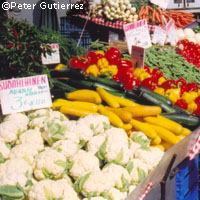Report highlights economics behind food quality schemes
The number of food quality assurance schemes (QAS) in Europe is growing constantly. Some highlight the region the product is from or the production method used; others cover issues such as the environment or animal welfare. They offer benefits to consumers who are able to make informed purchasing decisions, while producers are able to charge a higher price for these value-added products. Now the Joint Research Centre's Institute for Prospective Technological Studies (IPTS) has produced a detailed report of existing QAS in Europe, which analyses the costs and benefits of these schemes for farmers, traders, processors, retailers and consumers. One of the main aims of the report was to show how farmers producing to higher standards can retain a fair share of the added value. The study was carried out at the request of European Commission's Directorate-General for Agriculture and Rural Development, which had been asked to look into the issue by the European Parliament. It was presented at a recent conference on food quality certification organised by the European Commission. 'Quality production is a key issue for the Commission, to ensure the future of European agriculture and to promote rural development,' said Mariann Fischer Boel, European Commissioner for Agriculture and Rural Development. 'Quality logos are a good tool to promote quality but they only make sense when it is totally clear what they stand for. Each consumer must have the possibility to know what they mean.' In this latest study, researchers analysed the economics behind nine European QAS, including Protected Designations of Origin (PDOs) such as Parmigiano-Reggiano cheese, as well as internal management schemes such as the EurepGAP standard and the British Red Tractor label. The authors of the report make a clear distinction between QAS that aim to differentiate their product from other similar products on the market, such as PDOs, and QAS that aim to cover the whole market for a given product, such as EurepGAP. According to the report, the latter are largely buyer driven. 'The fact that EurepGAP is becoming a de-facto international standard for in-chain quality and safety management can be explained by effective collective action of the eight retailers behind the scheme and by the fact that through their market power they have been able to enforce the standards, as well as to pass on a significant part of the costs to producers,' the authors write. The report notes that costs of compliance with these kinds of schemes can be high, and suggests that support measures be set up to help with these. It also recommends that the EU support the ongoing trend in these QAS towards a more equitable share of the benefits and costs of the schemes. The biggest challenge for QAS based on differentiating a product is ensuring the effective organisation of a large number of small producers. The most successful schemes are based around pre-existing, well-functioning professional structures, such as the French Intra-Chain Committee for Comté Gruyere and the Italian Consortium for Parmigiano Reggiano. The authors recommend that where these structures are lacking, the collective action by small farmers must be facilitated and supported to help them negotiate effectively with other stakeholders. Promotion is also an important factor in the success of these schemes. 'Successful schemes have significant budgets for promotion which effectively create a brand in the market,' the report states. The report also concludes that, 'PDO have the potential to maintain and improve the position of European agriculture as a high-end producer of exclusive food products to high income consumers world-wide.' Another key recommendation concerns the registration process for PDOs. 'Obtaining PDO/PGI or TSG is a time-consuming and often non-transparent process,' the report states. 'There is a need to increase the speed of the registration process.' At the conference it was agreed that further research was needed into the economics of these schemes, and their impacts on farm incomes and rural development



